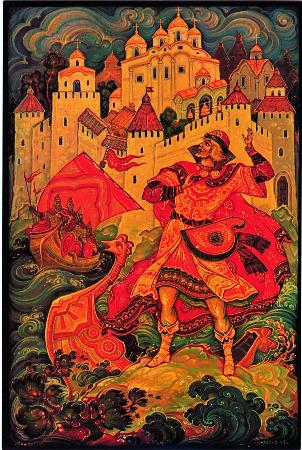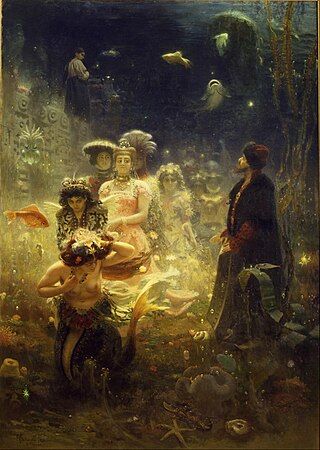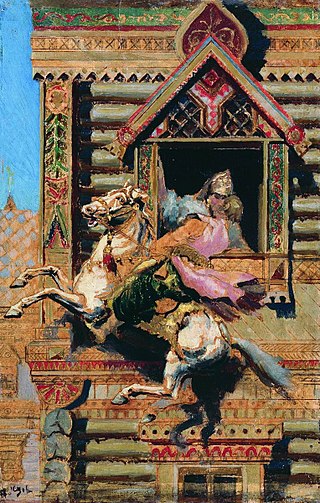
A bylina is a type of Russian oral epic poem.

The Tale of Tsar Saltan, of His Son the Renowned and Mighty Bogatyr Prince Gvidon Saltanovich and of the Beautiful Swan-Princess is an 1831 fairy tale in verse by Alexander Pushkin.

Aleksandr Lukich Ptushko was a Soviet animation and fantasy film director, and a People's Artist of the USSR (1969). Ptushko is frequently referred to as "the Soviet Walt Disney," because of his prominent early role in animation in the Soviet Union, though a more accurate comparison would be to Willis H. O'Brien or Ray Harryhausen. Some critics, such as Tim Lucas and Alan Upchurch, have also compared Ptushko to Italian filmmaker Mario Bava, who made fantasy and horror films with similarities to Ptushko's work and made similarly innovative use of color cinematography and special effects. He began his film career as a director and animator of stop motion short films, and became a director of feature-length films combining live action, stop motion, creative special effects, and Russian mythology. Along the way he would be responsible for a number of firsts in Russian film history, and would make several extremely popular and internationally praised films full of visual flair and spectacle.

A bogatyr or vityaz is a stock character in medieval East Slavic legends, akin to a Western European knight-errant. Bogatyrs appear mainly in Rus' epic poems—bylinas. Historically, they came into existence during the reign of Vladimir the Great as part of his elite warriors (druzhina), akin to Knights of the Round Table. Tradition describes bogatyrs as warriors of immense strength, courage and bravery, rarely using magic while fighting enemies in order to maintain the "loosely based on historical fact" aspect of bylinas. They are characterized as having resounding voices, with patriotic and religious pursuits, defending Rus' from foreign enemies and their religion. In modern Russian, the word bogatyr labels a courageous hero, an athlete or a physically strong man.

Alyosha Popovich, is a folk hero of Kievan Rus', appearing in Russian folklore. He is a bogatyr and the youngest of the three main bogatyrs, the other two being Dobrynya Nikitich and Ilya Muromets. All three are represented together in Viktor Vasnetsov's famous painting Bogatyrs.

Dobrynya Nikitich is one of the most popular bogatyrs from the "Kievan" series of Russian folklore based on bylina originating from the area around the capital of the Kievan Rus, Kiev. Albeit fictional, this character is based on a real warlord Dobrynya, who led the armies of Svyatoslav the Great and tutored his son Vladimir the Great.

Viktor Mikhaylovich Vasnetsov was a Russian artist who specialised in mythological and historical subjects. He is considered a co-founder of Russian folklorist and romantic nationalistic painting, and a key figure in the Russian Revivalist movement.

Sadko is the principal character in a Russian medieval epic bylina. He was an adventurer, merchant, and gusli musician from Novgorod.
Tugarin is a mythical creature in Eastern European bylinas and fairy tales, which personifies evil and cruelty and appears in a dragon-like form.

Nadezhda Ivanovna Zabela-Vrubel was an Imperial Russian opera singer, the niece of the Russian sculptor Parmen Zabela. Vocally, she is best described as a lyrical (coloratura) soprano, with a particularly high tessitura.

Sadko, Op. 5, is a Tableau musical, or Musical picture, by Nikolai Rimsky-Korsakov, written in 1867 and revised in 1869 and 1892. It is sometimes called the first symphonic poem written in Russia. It was first performed in 1867 at a concert of the Russian Musical Society (RMS), conducted by Mily Balakirev. Rimsky-Korsakov later wrote an opera of the same name which quotes freely from the earlier work. From the tone poem the composer quoted its most memorable passages in the opera, including the opening theme of the swelling sea, and other themes as leitmotifs – he himself set out to "utilize for this opera the material of my symphonic poem, and, in any event, to make use of its motives as leading motives for the opera".

Alexander Hilferding also spelled Aleksandar Fedorovich Giljferding was a Russian Imperial linguist and folklorist of German descent who collected some 318 bylinas in the Russian North.

Folklore of Russia is folklore of Russians and other ethnic groups of Russia.

Alexander Alexandrrovich Navrotsky was a Russian writer, poet and playwright, known also under his pen name N. A. Vrotsky. His best-known poem, "The Stenka Razin Cliff", set to music by himself, became popular among Russian revolutionaries in the late 19th-early 20th century and is now considered part of Russian musical folklore.
A Zmei Gorynich or zmei, in skazki and byliny, is a dragon or serpent, or sometimes a human-like character with dragon-like traits.
Russian Fairy Tales, or Russian Folk Tales may refer to :

The Sea Tsar and Vasilisa the Wise is a Russian fairy tale published by author Alexander Afanasyev in his collection of Russian Fairy Tales, numbered 219. The tale features legendary characters Tsar Morskoi and Vasilisa the Wise.
Moryana is a female sea spirit in Slavic folklore, possibly a goddess. Moryana was a sea vodyanitsa and daughter of the Morskoy Tsar, and also, according to some beliefs, she ruled the winds. Sometimes the moryany/moryanki were said to be numerous spirits of the sea and a marine kind of rusalki, which posed a great threat to ships, but usually Moryana was represented as a single entity.

Sadko, also known as Sadko in the Underwater Kingdom, is an oil-on-canvas painting by Ilya Repin, made in 1876 during a visit to France. Based on a Russian epic poem, it depicts the merchant and musician Sadko who must choose one of the daughters of the Underwater King to marry.

Sivko-Burko is a Russian fairy tale (skazka) collected by folklorist Alexandr Afanasyev in his three-volume compilation Russian Fairy Tales. The tale is a local form in Slavdom of tale type ATU 530, "The Princess on the Glass Mountain", wherein the hero has to jump higher and reach a tower or terem, instead of climbing up a steep and slippery mountain made entirely of glass.














